Report: Analyzing Inequalities in Child Oral Health and Interventions
VerifiedAdded on 2023/06/10
|6
|1480
|283
Report
AI Summary
This report provides a comprehensive overview of inequalities in child oral health. It explores various factors contributing to these disparities, including socioeconomic status, geographic location, and access to dental services. The report highlights the negative impacts of poor oral health on children's development, education, and overall well-being. It also examines different types of interventions to address these inequalities, such as the expansion of sealant delivery, promoting healthy eating habits, and increasing access to fluoridated water. The report emphasizes the importance of public health strategies to improve child oral health and reduce inequalities. The report concludes that social inequality in oral health is creating the biggest problem and different interventions can be adopted by public health.
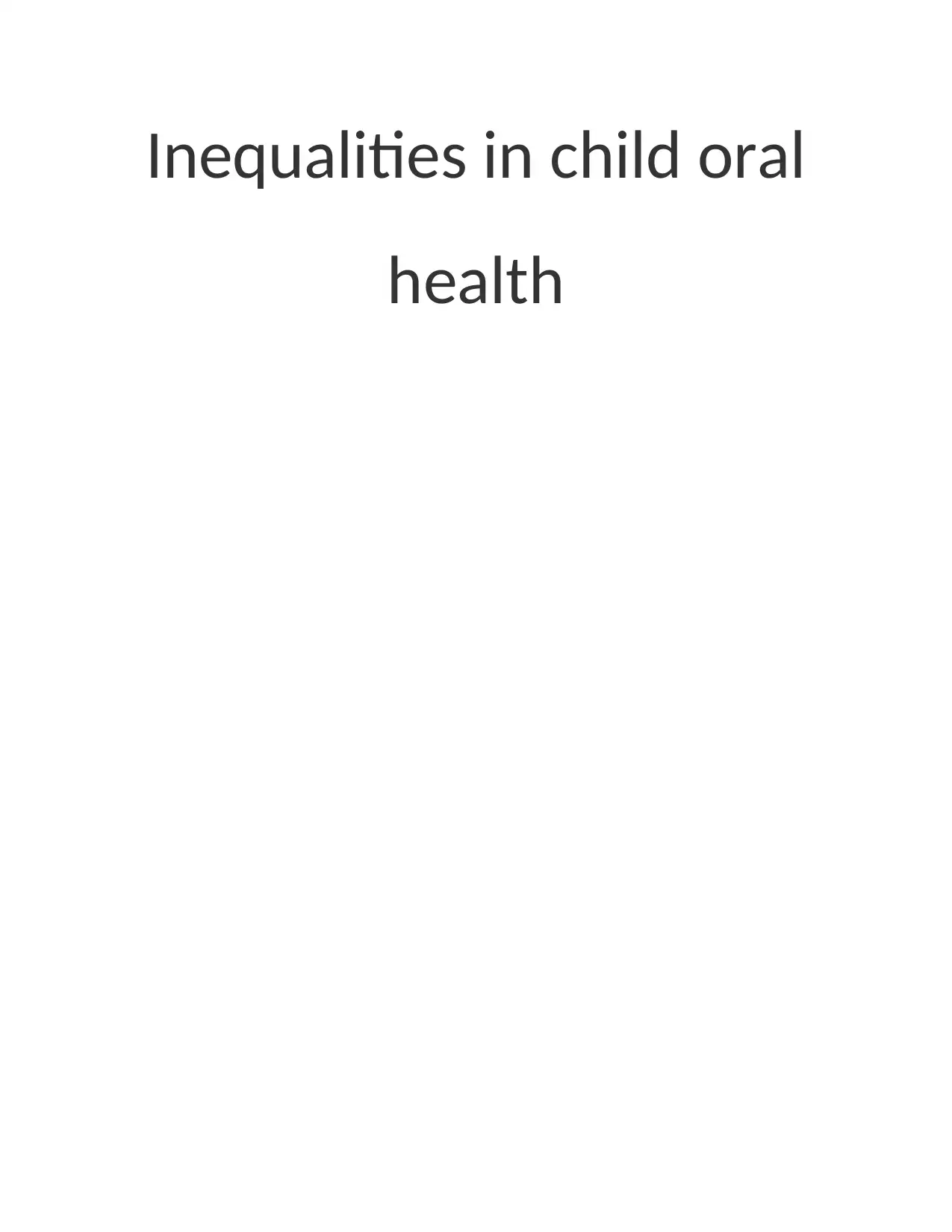
Inequalities in child oral
health
health
Paraphrase This Document
Need a fresh take? Get an instant paraphrase of this document with our AI Paraphraser

Contents
INTRODUCTION...........................................................................................................................1
MAIN BODY..................................................................................................................................1
CONCLUSION................................................................................................................................3
REFERENCES................................................................................................................................4
INTRODUCTION...........................................................................................................................1
MAIN BODY..................................................................................................................................1
CONCLUSION................................................................................................................................3
REFERENCES................................................................................................................................4
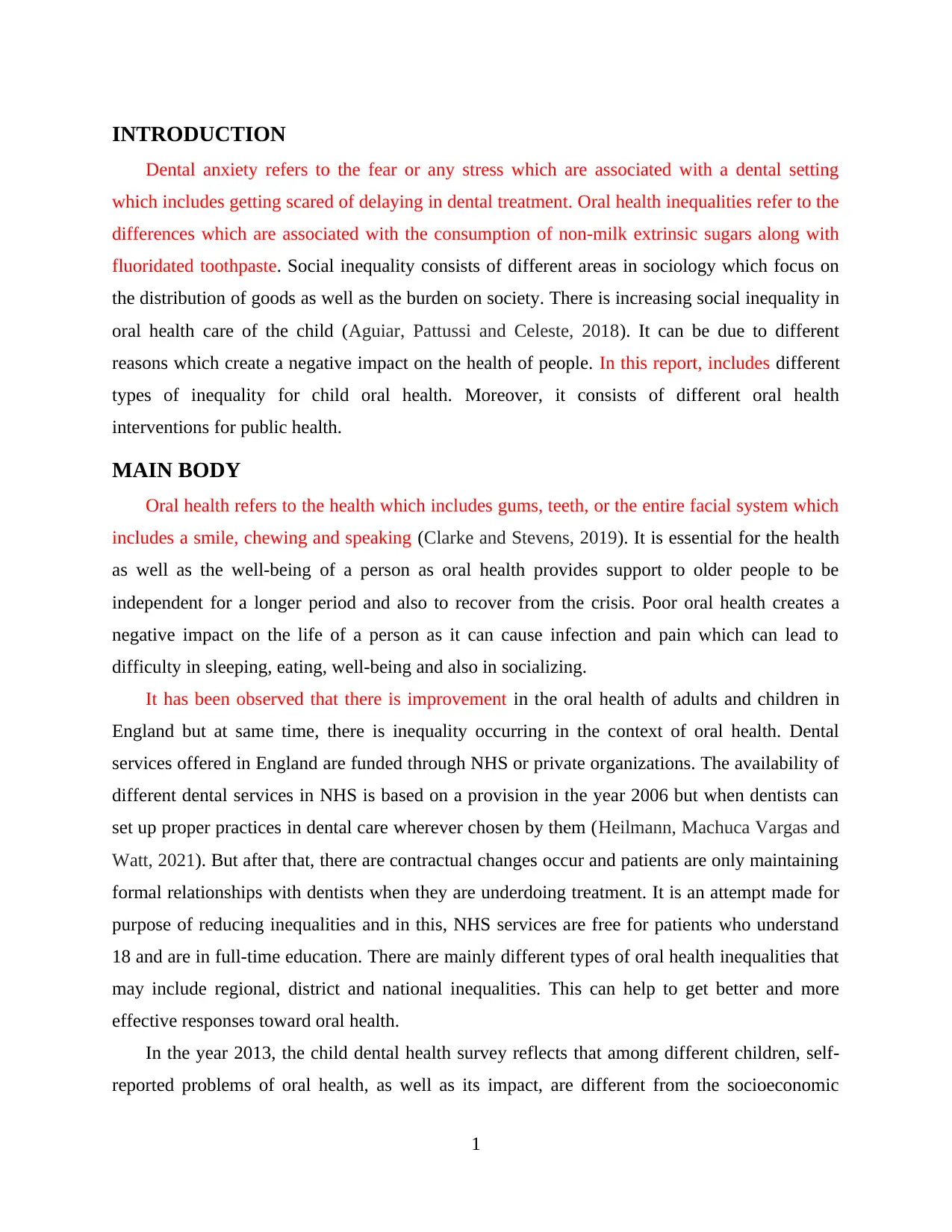
INTRODUCTION
Dental anxiety refers to the fear or any stress which are associated with a dental setting
which includes getting scared of delaying in dental treatment. Oral health inequalities refer to the
differences which are associated with the consumption of non-milk extrinsic sugars along with
fluoridated toothpaste. Social inequality consists of different areas in sociology which focus on
the distribution of goods as well as the burden on society. There is increasing social inequality in
oral health care of the child (Aguiar, Pattussi and Celeste, 2018). It can be due to different
reasons which create a negative impact on the health of people. In this report, includes different
types of inequality for child oral health. Moreover, it consists of different oral health
interventions for public health.
MAIN BODY
Oral health refers to the health which includes gums, teeth, or the entire facial system which
includes a smile, chewing and speaking (Clarke and Stevens, 2019). It is essential for the health
as well as the well-being of a person as oral health provides support to older people to be
independent for a longer period and also to recover from the crisis. Poor oral health creates a
negative impact on the life of a person as it can cause infection and pain which can lead to
difficulty in sleeping, eating, well-being and also in socializing.
It has been observed that there is improvement in the oral health of adults and children in
England but at same time, there is inequality occurring in the context of oral health. Dental
services offered in England are funded through NHS or private organizations. The availability of
different dental services in NHS is based on a provision in the year 2006 but when dentists can
set up proper practices in dental care wherever chosen by them (Heilmann, Machuca Vargas and
Watt, 2021). But after that, there are contractual changes occur and patients are only maintaining
formal relationships with dentists when they are underdoing treatment. It is an attempt made for
purpose of reducing inequalities and in this, NHS services are free for patients who understand
18 and are in full-time education. There are mainly different types of oral health inequalities that
may include regional, district and national inequalities. This can help to get better and more
effective responses toward oral health.
In the year 2013, the child dental health survey reflects that among different children, self-
reported problems of oral health, as well as its impact, are different from the socioeconomic
1
Dental anxiety refers to the fear or any stress which are associated with a dental setting
which includes getting scared of delaying in dental treatment. Oral health inequalities refer to the
differences which are associated with the consumption of non-milk extrinsic sugars along with
fluoridated toothpaste. Social inequality consists of different areas in sociology which focus on
the distribution of goods as well as the burden on society. There is increasing social inequality in
oral health care of the child (Aguiar, Pattussi and Celeste, 2018). It can be due to different
reasons which create a negative impact on the health of people. In this report, includes different
types of inequality for child oral health. Moreover, it consists of different oral health
interventions for public health.
MAIN BODY
Oral health refers to the health which includes gums, teeth, or the entire facial system which
includes a smile, chewing and speaking (Clarke and Stevens, 2019). It is essential for the health
as well as the well-being of a person as oral health provides support to older people to be
independent for a longer period and also to recover from the crisis. Poor oral health creates a
negative impact on the life of a person as it can cause infection and pain which can lead to
difficulty in sleeping, eating, well-being and also in socializing.
It has been observed that there is improvement in the oral health of adults and children in
England but at same time, there is inequality occurring in the context of oral health. Dental
services offered in England are funded through NHS or private organizations. The availability of
different dental services in NHS is based on a provision in the year 2006 but when dentists can
set up proper practices in dental care wherever chosen by them (Heilmann, Machuca Vargas and
Watt, 2021). But after that, there are contractual changes occur and patients are only maintaining
formal relationships with dentists when they are underdoing treatment. It is an attempt made for
purpose of reducing inequalities and in this, NHS services are free for patients who understand
18 and are in full-time education. There are mainly different types of oral health inequalities that
may include regional, district and national inequalities. This can help to get better and more
effective responses toward oral health.
In the year 2013, the child dental health survey reflects that among different children, self-
reported problems of oral health, as well as its impact, are different from the socioeconomic
1
⊘ This is a preview!⊘
Do you want full access?
Subscribe today to unlock all pages.

Trusted by 1+ million students worldwide
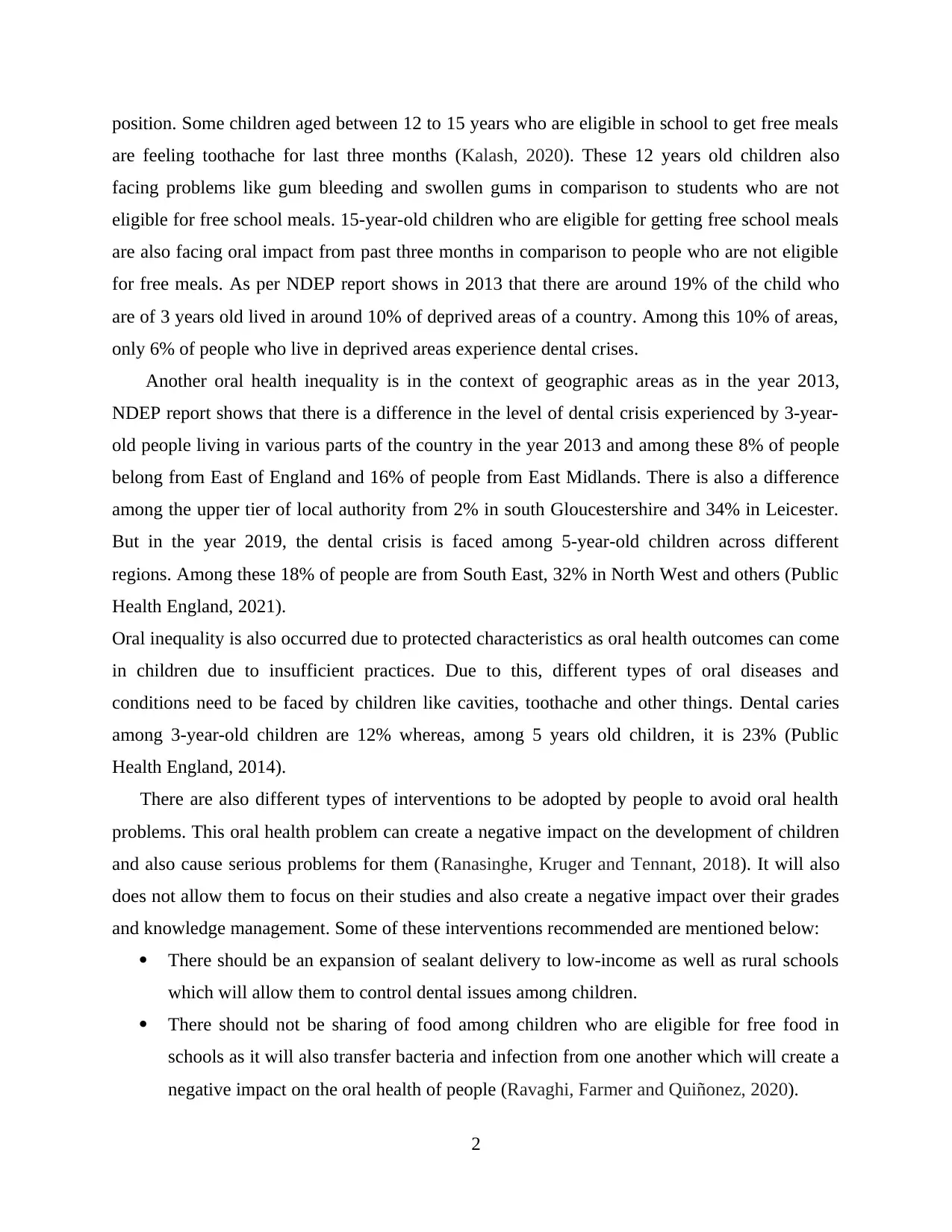
position. Some children aged between 12 to 15 years who are eligible in school to get free meals
are feeling toothache for last three months (Kalash, 2020). These 12 years old children also
facing problems like gum bleeding and swollen gums in comparison to students who are not
eligible for free school meals. 15-year-old children who are eligible for getting free school meals
are also facing oral impact from past three months in comparison to people who are not eligible
for free meals. As per NDEP report shows in 2013 that there are around 19% of the child who
are of 3 years old lived in around 10% of deprived areas of a country. Among this 10% of areas,
only 6% of people who live in deprived areas experience dental crises.
Another oral health inequality is in the context of geographic areas as in the year 2013,
NDEP report shows that there is a difference in the level of dental crisis experienced by 3-year-
old people living in various parts of the country in the year 2013 and among these 8% of people
belong from East of England and 16% of people from East Midlands. There is also a difference
among the upper tier of local authority from 2% in south Gloucestershire and 34% in Leicester.
But in the year 2019, the dental crisis is faced among 5-year-old children across different
regions. Among these 18% of people are from South East, 32% in North West and others (Public
Health England, 2021).
Oral inequality is also occurred due to protected characteristics as oral health outcomes can come
in children due to insufficient practices. Due to this, different types of oral diseases and
conditions need to be faced by children like cavities, toothache and other things. Dental caries
among 3-year-old children are 12% whereas, among 5 years old children, it is 23% (Public
Health England, 2014).
There are also different types of interventions to be adopted by people to avoid oral health
problems. This oral health problem can create a negative impact on the development of children
and also cause serious problems for them (Ranasinghe, Kruger and Tennant, 2018). It will also
does not allow them to focus on their studies and also create a negative impact over their grades
and knowledge management. Some of these interventions recommended are mentioned below:
There should be an expansion of sealant delivery to low-income as well as rural schools
which will allow them to control dental issues among children.
There should not be sharing of food among children who are eligible for free food in
schools as it will also transfer bacteria and infection from one another which will create a
negative impact on the oral health of people (Ravaghi, Farmer and Quiñonez, 2020).
2
are feeling toothache for last three months (Kalash, 2020). These 12 years old children also
facing problems like gum bleeding and swollen gums in comparison to students who are not
eligible for free school meals. 15-year-old children who are eligible for getting free school meals
are also facing oral impact from past three months in comparison to people who are not eligible
for free meals. As per NDEP report shows in 2013 that there are around 19% of the child who
are of 3 years old lived in around 10% of deprived areas of a country. Among this 10% of areas,
only 6% of people who live in deprived areas experience dental crises.
Another oral health inequality is in the context of geographic areas as in the year 2013,
NDEP report shows that there is a difference in the level of dental crisis experienced by 3-year-
old people living in various parts of the country in the year 2013 and among these 8% of people
belong from East of England and 16% of people from East Midlands. There is also a difference
among the upper tier of local authority from 2% in south Gloucestershire and 34% in Leicester.
But in the year 2019, the dental crisis is faced among 5-year-old children across different
regions. Among these 18% of people are from South East, 32% in North West and others (Public
Health England, 2021).
Oral inequality is also occurred due to protected characteristics as oral health outcomes can come
in children due to insufficient practices. Due to this, different types of oral diseases and
conditions need to be faced by children like cavities, toothache and other things. Dental caries
among 3-year-old children are 12% whereas, among 5 years old children, it is 23% (Public
Health England, 2014).
There are also different types of interventions to be adopted by people to avoid oral health
problems. This oral health problem can create a negative impact on the development of children
and also cause serious problems for them (Ranasinghe, Kruger and Tennant, 2018). It will also
does not allow them to focus on their studies and also create a negative impact over their grades
and knowledge management. Some of these interventions recommended are mentioned below:
There should be an expansion of sealant delivery to low-income as well as rural schools
which will allow them to control dental issues among children.
There should not be sharing of food among children who are eligible for free food in
schools as it will also transfer bacteria and infection from one another which will create a
negative impact on the oral health of people (Ravaghi, Farmer and Quiñonez, 2020).
2
Paraphrase This Document
Need a fresh take? Get an instant paraphrase of this document with our AI Paraphraser
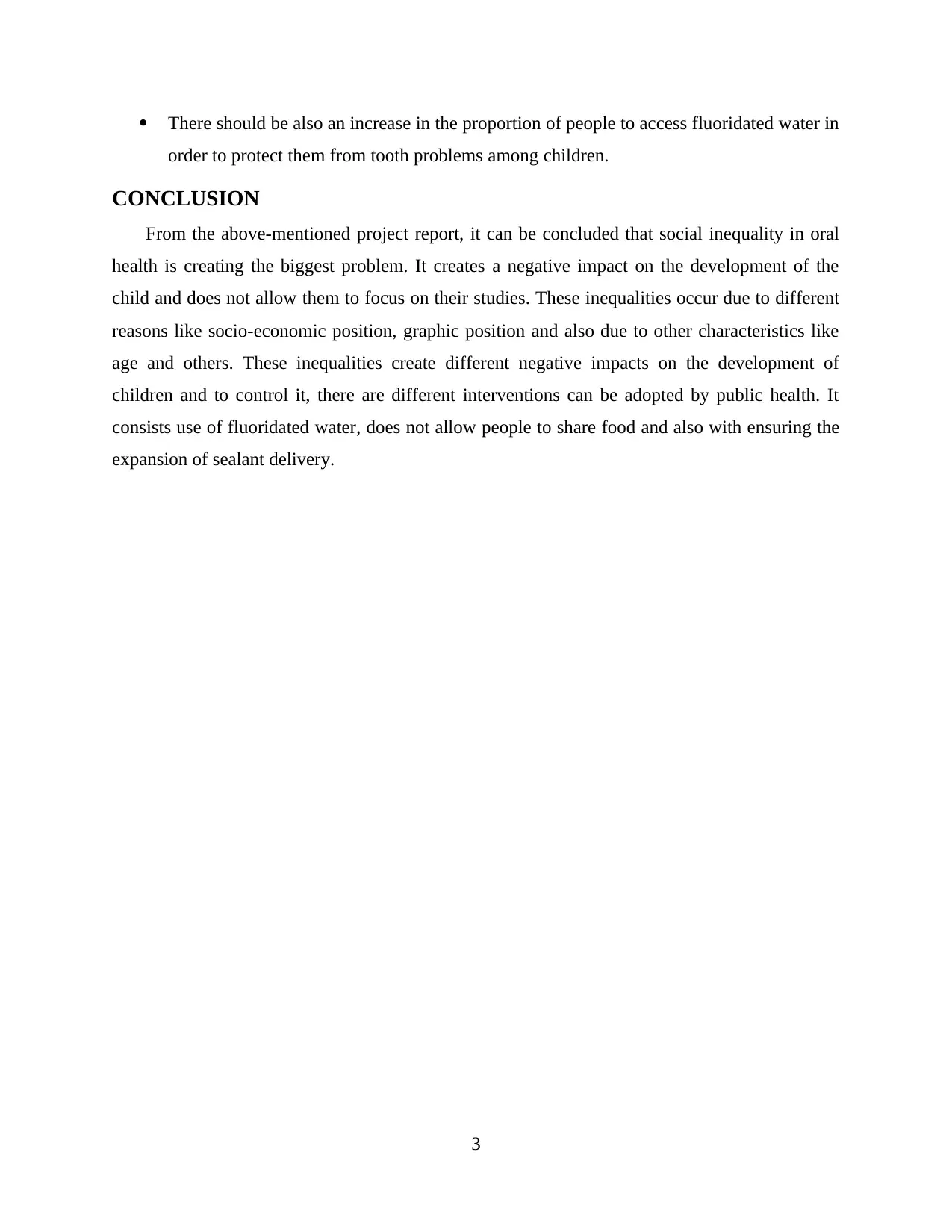
There should be also an increase in the proportion of people to access fluoridated water in
order to protect them from tooth problems among children.
CONCLUSION
From the above-mentioned project report, it can be concluded that social inequality in oral
health is creating the biggest problem. It creates a negative impact on the development of the
child and does not allow them to focus on their studies. These inequalities occur due to different
reasons like socio-economic position, graphic position and also due to other characteristics like
age and others. These inequalities create different negative impacts on the development of
children and to control it, there are different interventions can be adopted by public health. It
consists use of fluoridated water, does not allow people to share food and also with ensuring the
expansion of sealant delivery.
3
order to protect them from tooth problems among children.
CONCLUSION
From the above-mentioned project report, it can be concluded that social inequality in oral
health is creating the biggest problem. It creates a negative impact on the development of the
child and does not allow them to focus on their studies. These inequalities occur due to different
reasons like socio-economic position, graphic position and also due to other characteristics like
age and others. These inequalities create different negative impacts on the development of
children and to control it, there are different interventions can be adopted by public health. It
consists use of fluoridated water, does not allow people to share food and also with ensuring the
expansion of sealant delivery.
3
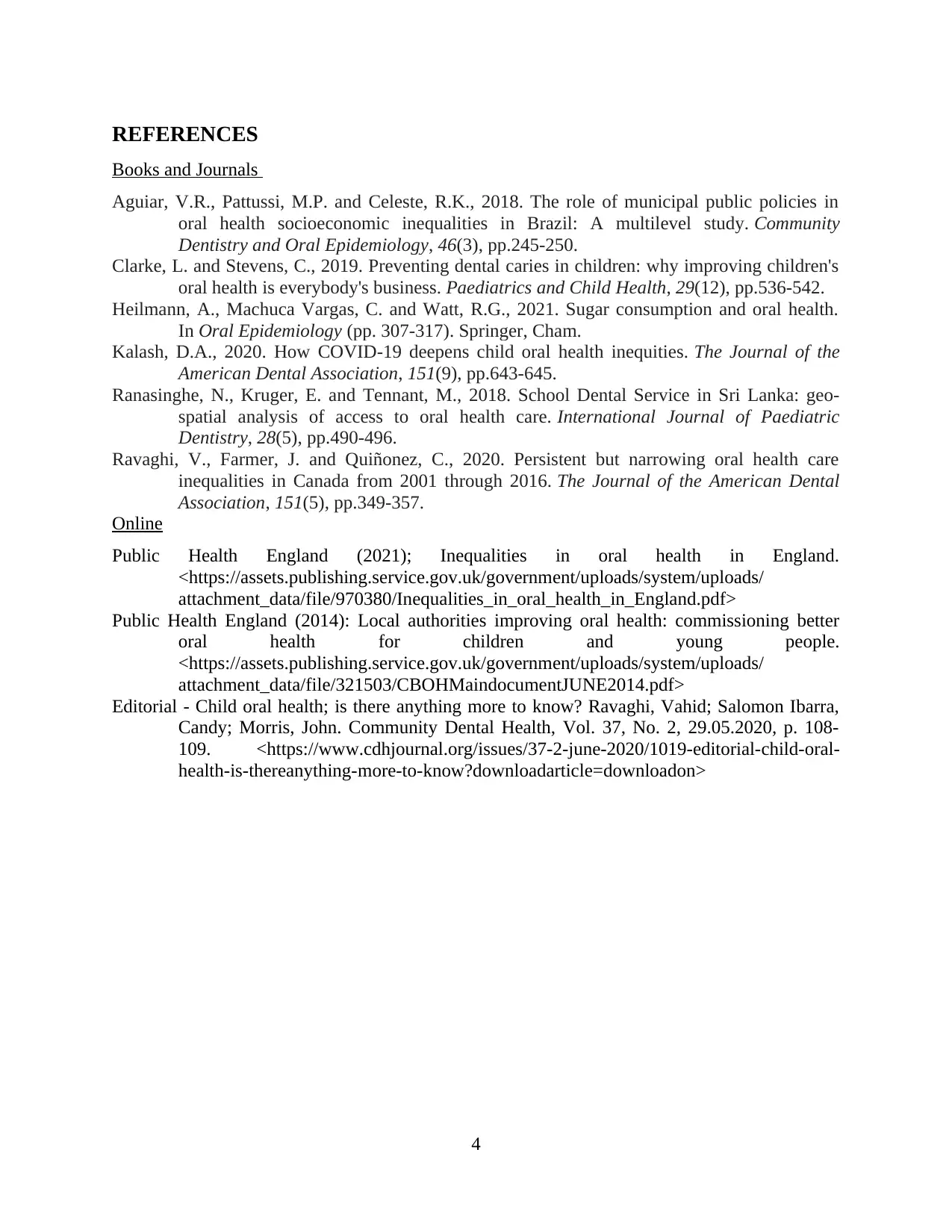
REFERENCES
Books and Journals
Aguiar, V.R., Pattussi, M.P. and Celeste, R.K., 2018. The role of municipal public policies in
oral health socioeconomic inequalities in Brazil: A multilevel study. Community
Dentistry and Oral Epidemiology, 46(3), pp.245-250.
Clarke, L. and Stevens, C., 2019. Preventing dental caries in children: why improving children's
oral health is everybody's business. Paediatrics and Child Health, 29(12), pp.536-542.
Heilmann, A., Machuca Vargas, C. and Watt, R.G., 2021. Sugar consumption and oral health.
In Oral Epidemiology (pp. 307-317). Springer, Cham.
Kalash, D.A., 2020. How COVID-19 deepens child oral health inequities. The Journal of the
American Dental Association, 151(9), pp.643-645.
Ranasinghe, N., Kruger, E. and Tennant, M., 2018. School Dental Service in Sri Lanka: geo‐
spatial analysis of access to oral health care. International Journal of Paediatric
Dentistry, 28(5), pp.490-496.
Ravaghi, V., Farmer, J. and Quiñonez, C., 2020. Persistent but narrowing oral health care
inequalities in Canada from 2001 through 2016. The Journal of the American Dental
Association, 151(5), pp.349-357.
Online
Public Health England (2021); Inequalities in oral health in England.
<https://assets.publishing.service.gov.uk/government/uploads/system/uploads/
attachment_data/file/970380/Inequalities_in_oral_health_in_England.pdf>
Public Health England (2014): Local authorities improving oral health: commissioning better
oral health for children and young people.
<https://assets.publishing.service.gov.uk/government/uploads/system/uploads/
attachment_data/file/321503/CBOHMaindocumentJUNE2014.pdf>
Editorial - Child oral health; is there anything more to know? Ravaghi, Vahid; Salomon Ibarra,
Candy; Morris, John. Community Dental Health, Vol. 37, No. 2, 29.05.2020, p. 108-
109. <https://www.cdhjournal.org/issues/37-2-june-2020/1019-editorial-child-oral-
health-is-thereanything-more-to-know?downloadarticle=downloadon>
4
Books and Journals
Aguiar, V.R., Pattussi, M.P. and Celeste, R.K., 2018. The role of municipal public policies in
oral health socioeconomic inequalities in Brazil: A multilevel study. Community
Dentistry and Oral Epidemiology, 46(3), pp.245-250.
Clarke, L. and Stevens, C., 2019. Preventing dental caries in children: why improving children's
oral health is everybody's business. Paediatrics and Child Health, 29(12), pp.536-542.
Heilmann, A., Machuca Vargas, C. and Watt, R.G., 2021. Sugar consumption and oral health.
In Oral Epidemiology (pp. 307-317). Springer, Cham.
Kalash, D.A., 2020. How COVID-19 deepens child oral health inequities. The Journal of the
American Dental Association, 151(9), pp.643-645.
Ranasinghe, N., Kruger, E. and Tennant, M., 2018. School Dental Service in Sri Lanka: geo‐
spatial analysis of access to oral health care. International Journal of Paediatric
Dentistry, 28(5), pp.490-496.
Ravaghi, V., Farmer, J. and Quiñonez, C., 2020. Persistent but narrowing oral health care
inequalities in Canada from 2001 through 2016. The Journal of the American Dental
Association, 151(5), pp.349-357.
Online
Public Health England (2021); Inequalities in oral health in England.
<https://assets.publishing.service.gov.uk/government/uploads/system/uploads/
attachment_data/file/970380/Inequalities_in_oral_health_in_England.pdf>
Public Health England (2014): Local authorities improving oral health: commissioning better
oral health for children and young people.
<https://assets.publishing.service.gov.uk/government/uploads/system/uploads/
attachment_data/file/321503/CBOHMaindocumentJUNE2014.pdf>
Editorial - Child oral health; is there anything more to know? Ravaghi, Vahid; Salomon Ibarra,
Candy; Morris, John. Community Dental Health, Vol. 37, No. 2, 29.05.2020, p. 108-
109. <https://www.cdhjournal.org/issues/37-2-june-2020/1019-editorial-child-oral-
health-is-thereanything-more-to-know?downloadarticle=downloadon>
4
⊘ This is a preview!⊘
Do you want full access?
Subscribe today to unlock all pages.

Trusted by 1+ million students worldwide
1 out of 6
Related Documents
Your All-in-One AI-Powered Toolkit for Academic Success.
+13062052269
info@desklib.com
Available 24*7 on WhatsApp / Email
![[object Object]](/_next/static/media/star-bottom.7253800d.svg)
Unlock your academic potential
Copyright © 2020–2025 A2Z Services. All Rights Reserved. Developed and managed by ZUCOL.





